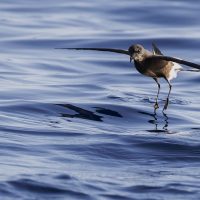This post is also available in: Swedish
Madeiran storm petrel – Oceanodroma castro
Madeiran storm petrel – Oceanodroma castro
or Band-rumped storm petrel, is of the storm petrel family Hydrobatidae.
The Madeiran storm petrel is 19–21 cm in length with a 43–46 cm wingspan, and weighs 44–49 g. It is mainly brownish black with an extensive white rump. Similar to Leach’s storm petrel with the forked tail, long wings, but Leach’s has a more deeply forked tail, a differently shaped (V-shaped or triangular) white rump, and a ‘tern-like’ flight, whereas the Madeiran storm petrel has a more ‘shearwater-like’ flight.
The species breeds on islands in the warmer parts of the Atlantic and Pacific Oceans. These include Farilhão Grande (a few tens of kilometres off mainland Portugal), the Azores, Madeira and the Canary Islands in the Atlantic, and the Galapagos Islands in the Pacific. In 2018, the species was reported to have also started breeding on the Mauna Loa volcano on the Hawaiian Islands. Birds nest in colonies close to the sea in rock crevices and females lay a single white egg per breeding attempt. The Madeiran storm petrel spends the non-breeding period at sea. Individuals feed by picking up prey items (invertebrates, small vertebrates and sometimes carrion) from the water surface. A study aiming to determine the diving abilities of this species was actually conducted on the ‘warm season’ population from the Azores, which was later recognized as a distinct species (see below).
The Madeiran storm petrel is strictly nocturnal at its breeding sites to avoid predation by gulls and diurnal raptors such as peregrines, and will even avoid coming to land on clear moonlit nights. Like most petrels, its walking ability is limited to a short shuffle from/to the burrow.
Recent discoveries of ‘cold season’ and ‘warm season’ populations, which use the same nest sites at different times of year, and also differ in terms of vocalisations and moulting period, may hint at the existence of two ‘cryptic species’ within the currently understood limits of the species. After population genetics analyses of mtDNA the warm season population in the Azores was recognized as a separate species, Monteiro’s storm petrel.
It sounds like this
Recording by James Bradley from Xeno canto







